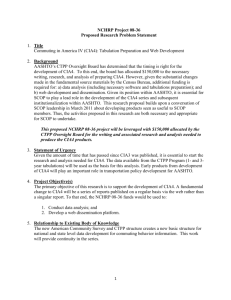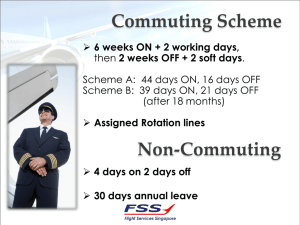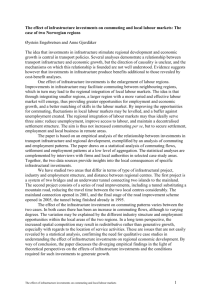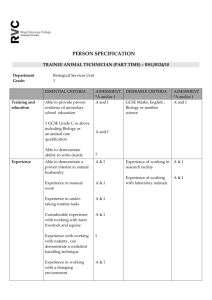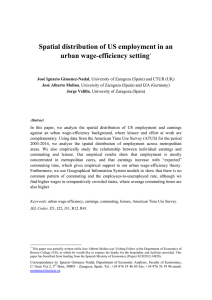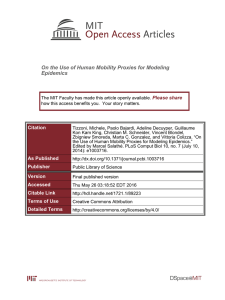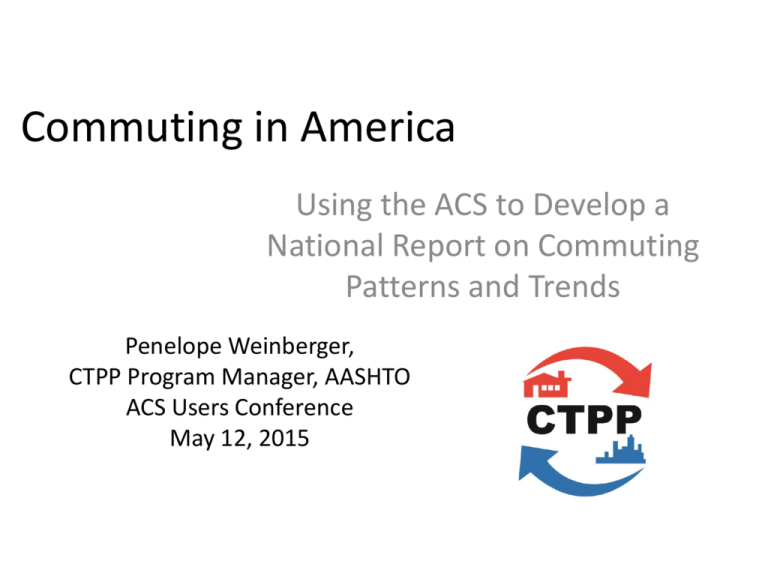
Commuting in America
Using the ACS to Develop a
National Report on Commuting
Patterns and Trends
Penelope Weinberger,
CTPP Program Manager, AASHTO
ACS Users Conference
May 12, 2015
What is the CTPP?
• The Census Transportation Planning Products Program
• A Technical Service Program of the American
Association of State Highway and Transportation
Officials (AASHTO)
• Uses a special or custom tabulation of the ACS –
Journey to Work data
• Transportation agencies have purchased JTW Census
data since 1970 – National coordinated effort began in
1980
• Current program funded through 2018, anticipates
purchase of seventh large scale tabulation based on
2012 – 2016 ACS
Besides Data…
• Training and technical assistance
– Workshops
– Classes
– E-Learning
– Webinars
– Short videos
• Research
– Transportation Research Board
– Self funded
(historic) Commuting in
America
Data Sources for previous CIAs
• Census 2000 Long Form data (and predecessors)
and Decennial Census
• Census Transportation Planning Products
(CTPP2000)
• National Household Travel Survey/Nationwide
Personal Transportation Survey
• American Housing Survey
• Consumer Expenditure Survey
• Transportation Energy Book
Commuting in America
• Research is partly
CTPP direct funded
($275,000) and
partly NCHRP 8-36
Task 111 ($125,000)
• NCHRP task
developed data
• The rest was for
analysis, writing,
production, etc.
Project Team
• Dr. Steven Polzin, Center for Urban
Transportation Research, USF
• Alan Pisarski, Consultant
• Dr. Bruce Spear, Cambridge Systematics
• Nancy McGuckin, Consultant
• Dr. Liang Long, Cambridge Systematics
• Dr. Matthew Hardy, AASHTO
Topics in CIA
• The Role of Commuting in
Overall Travel
• Population and Worker
Trends
• Population and Worker
Dynamics
• The Nature and Pattern of
Jobs
• Job Dynamics
• Vehicle and Transit
Availability
• Consumer Spending on
Transportation
• How Commuting Influences
Travel
• Commuting Mode Choice
• Commuting Departure Time
and Trip Time
• Auto Commuting
• Transit Commuting
• Bicycling and Walk
Commuting
• Commuting Flow Patterns
• The Evolving Role of
Commuting
Major findings
• Commuting:
–
–
–
–
–
–
–
–
–
16% of person trips
19% of Person Miles and Travel Time
28% of Household Vehicle Miles of Travel
Drove Alone increasing
Carpool declining
38% of workers leave for work between 7 and 8:30
Commute time increases with income
Work at home also increases with income
Change has been modest
Data Sources
• American Community Survey
• CTPP based on 2006 – 2010 ACS
• National Household Travel Survey
–
–
–
–
–
–
–
–
–
Decennial Census
American Housing Survey
Consumer Expenditure Survey
Longitudinal Employment Household Dynamics
2012 National Population Projections
National Intercensal Estimates (2000-2010)
Current Population Survey
Transportation Energy Data Book
National Transit Database
ACS Data
• 2005, 06, 07, 08, 09, 10, 11 DP03 Selected Economic
Characteristics
• 2007 – 2011 DP03 Selected Economic Characteristics
• 2010 DP04 Selected Housing Characteristics
• 2010 S0201 Selected Population Profile
• 2011 S2301 Employment Status
• 2011 B23001 Sex by Age by Employment Status
• 2011 B08202 Household Size by Number of Workers
• 2011 S2302 Employment Characteristics of Families
• 2011 S0701 Geographic Mobility
• 2011 S0702 Movers Among Regions
• 2006 – 2010 Commuter Adjusted Daytime Population
• 2011 ACS PUMS – many custom tabulations
And of Course:
•
•
•
•
•
•
•
•
•
•
•
•
•
2010 B08301 Means of Transportation to Work (MOT)
2010 B08303 Travel Time to Work
2010 B08101 MOT by Age
2010 S0801 Commuting Characteristics by Sex
2010 B08006 Sex by MOT
2010 B08105 MOT (Black, American Indian, Asian, White, nonHispanic, Hispanic)
2010 C08203 Workers by Vehicles Available
2010 B08141 MOT by Vehicles Available
2010 B08124 MOT by Occupation
2010 B08126 MOT by Industry
2007 – 2011 GCT0801 Mean Travel Time to Work
2010 B08534 - Means of Transportation to Work by Travel Time to
Work for Workplace Geography
2010 B08007 - Sex of Workers by Place of Work
So Basically
–
–
–
–
–
–
–
–
Age
Race/Ethnicity
Sex
Mobility
Employment
Industry
Occupation
Income
• Every Means of Transportation table you can
think of, Arrival Time, and Auto Ownership
• Custom Public Use Micro Sample tabs
About the data
• Sole nationwide, detailed geographically
comprehensive source of data on commuting
patterns
• Uniform
• Definitional comparability
• Sample was once 17% of households per
decade; is now ~2% annually (large Margins of
Error)
Limitations of ACS
• No Multiple Modes (Single mode collected –
longest distance portion of trip)
• No second jobs
• No variation in “usual” pattern (occasional or
regular but not always telecommute)
• No trip chains
• Lack of “three way” tabulations
• Period estimates conflict with point in time data
Improvements in ACS
• More workplace data than ever before
• More current/Continuous
• More consistent with data sets that come out
more regularly such as CEX
• FactFinder strong on MOE awareness
• No more 5 – 6 year wait for data
• No more 10 – 12 year gap for trend analysis
Questions?

